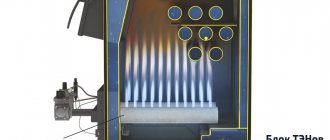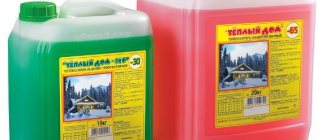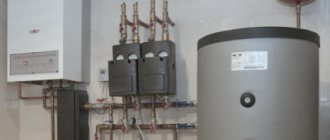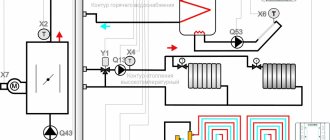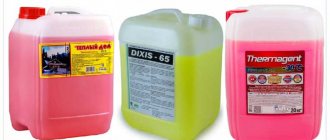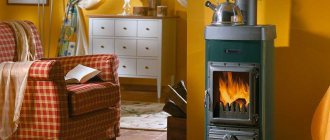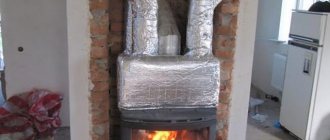A high level of comfort in a country house is impossible without heating. If previously there was little choice: firewood or electricity, now there are many more options. Any prudent owner wants the chosen method to support the ability to heat a large area of the room, to be safe, and not to break the budget. In order not to make a mistake with the choice, we will consider each heating option in more detail.
Gas heating
Gas heating is an ideal option in a country house. Round-the-clock warmth in the house at minimal cost - what else is needed. This type has a significant number of advantages:
- acceptable price;
- the ability to select the optimal boiler power depending on the heated area;
- the presence of a thermostat that allows you to control the heat level;
- high equipment reliability;
- long service life of the equipment;
- there is no need to regularly monitor and clean the equipment.
There were also some downsides:
- permitting documentation is required due to the high danger;
- regular inspection of equipment by specialists is necessary;
- Since carbon dioxide is released, ventilation is needed.
Of course, gas heating in a country house is possible if a main gas pipeline is connected. Unfortunately, the level of gasification in Russia is still at a negligible level. When it comes to the impracticality of building a highway or remote areas, you can forget about gas.
There is an option to install an autonomous gas holder, that is, a gas storage tank. In this case, all the advantages of gas heating are preserved, and the complete independence of the owner of a country house is added.
But the gas tank requires increased care and compliance with safety rules. For example, it is prohibited to fill a container with gas more than 85%. To this must be added regular inspections and considerable costs for installing and filling the cylinder.
Criteria for choosing a heating system
When choosing the optimal heating system for a private home, you need to pay attention to the following parameters:
- the presence or absence of a main gas pipeline (about 67% of the territory in Russia is gasified);
- availability of fuels;
- approximate consumption of thermal energy (calculated in kW per square meter of area, if water is used as a coolant, then calculations are carried out in Gcal);
- presence/absence of communications (branches of main electrical networks, etc.);
- autonomous or connected to central heating networks.
Of course, it is necessary to take into account a lot of secondary criteria, such as the material from which the house is made, the climatic features of the area (for example, in the Far North it is simply physically impossible to use liquid fuel for heating, which loses its flammability already at -30C° - -35C °).
Pros and cons of different heating systems
Solid fuel
Solid fuel heating systems are the oldest and most traditional. Of course, in modern houses there are usually no stoves, but solid fuel boilers are widespread.
Their advantages include the following:
- economical fuel (average cost of 1 ton of coke - $350, 1 m³ of birch firewood - $25, 1 ton of coal - $76);
- solid fuel boilers can also be combined (work, for example, on both gas and solid fuel);
- variability (in addition to the listed types of fuel, you can use others - dry manure, etc.);
- autonomy;
- easy installation.
Schematic representation of a solid fuel wood boiler
For a more visual representation of efficiency, the following data can be provided (calculated for a boiler heating 100 m² of living space)
- the average cost of heating a house for one month with a gas boiler is $10-$12;
- electric heater – 12$-20$;
- solid fuel boiler – 5$-7$.
Solid fuel heating systems also have disadvantages:
- The efficiency of a boiler or furnace never exceeds 65%-70%, and to achieve the maximum coefficient, special combustion conditions are required (almost complete vacuum);
- minimum degree of environmental friendliness (presence of soot, soot, and other sediments);
- unsafe use (you must constantly ensure that carbon monoxide does not enter the room - you can use a special sensor for this);
- different frequency of fuel loading, depending on the brand of boiler;
- a rather expensive pump often breaks down;
- the need for auxiliary devices such as a boiler and heat storage tank.
When using solid fuel boilers, the Ministry of Emergency Situations recommends installing sensors to determine the concentration of carbon monoxide in the room. This can be a lifesaver for forgetful owners.
Liquid fuel
Diesel and gasoline are usually used as liquid fuels for heating. True, sometimes alternative fuels can be used: aviation kerosene, oil refining waste (fuel oil) and others. So, “exotic” is good only if the owner of a private house has access to a large amount of such fuel, and also neglects environmental standards: the same fuel oil can make the room so smoky that it will no longer be possible to clean it with your own hands.
Liquid fuel boiler: inside view
Advantages of an liquid fuel heating system:
- almost complete automation of the entire system;
- availability of fuel (not in the material, but in the physical sense);
- independence from external energy sources;
- relatively high efficiency (efficiency in liquid fuel boilers can reach 95%).
Unfortunately, the liquid fuel heating system has many more disadvantages than advantages:
- the high cost of the boiler itself and the burners for it (for example, the price of one of the most inexpensive boilers of this type, Kiturami STS 13 Oil, starts in Russia from $700-750, and its maximum power is quite small - 16.8 W);
- the relatively high cost of diesel fuel (the cost of “diesel” at domestic gas stations ranges from 45 to 52 cents);
- the need for a special room for using the boiler, as well as fuel containers;
- too much pressure is created in the boiler, the pressure of which must be manually adjusted all the time;
- the specific smell of the fuel itself and its combustion products;
- When gasoline or diesel is burned, sulfur oxide is released (up to 3% of the burned volume), which leads to metal corrosion and rapid boiler failure.
Electrical
Electric heating systems can be divided into 2 types:
- electrode;
- induction;
Electric boiler connection diagram
Electrode ones involve the use, as you might guess, of an electric boiler. The advantages here include simplicity of design, relatively low cost, high efficiency and minimal heat loss. But the disadvantages are also very significant: electric current can shock a person (the presence of an open electrode is always dangerous), low power and the need to prepare the coolant itself (antifreeze or water) to achieve its maximum thermal conductivity.
Induction heaters carry out heating this way: the coolant in them is heated by an induction element (the principle of operation is similar to the operation of a conventional electric heater), which begins to produce heat using a current that occurs when a magnetic field appears inside the boiler tank (the system is quite complex). Induction boilers have several advantages: a high degree of safety, the absence of separate heating elements that can break; rapid heating of water and its supply through pipes to all rooms, higher efficiency. Disadvantages include high cost and lack of natural ventilation inside the boiler.
Operation of an induction electric boiler
Gas
Gas heating systems have the following advantages:
- gas is the cheapest fuel in Russia, if you do not take into account coal and coke;
- high efficiency (up to 99%);
- long service life (a cast iron boiler can last at least 30 years, a steel one - 50 years).
Negative sides:
- installation of a boiler of this type must be carried out under the control of special services (technical inventory bureau), the design and layout will also have to be coordinated with various authorities;
- Seasonal pressure surges in main gas pipelines can damage equipment.
Features of using heating systems depending on the material of the house:
The ideal option for a wooden house is gas boilers, since the wood will not absorb combustion products and soot and other deposits will not appear on it. For brick and foam block houses, everything is different. If the house area is from 200 m², it is better to use solid fuel heating systems; for buildings with an area from 100 m² to 200 m² - electric. Smaller residential buildings can also be heated with liquid fuel systems.
Calculation of gas boiler power and choice of coolant
For rooms with a ceiling height of up to 3 meters, the boiler power must be determined as follows: 1 kW of power per 10 m² of territory. You should be careful with gas boilers: the fact is that manufacturers indicate their power based on the optimal gas pressure in the pipeline (this is approximately 13-15 bar). In fact, the pressure is very often much lower, which is why the boiler will work only at a third of its real value.
If the house has a large area, then you should not buy one powerful boiler: it is better to buy several, but of lower power
Calculating the power of a gas boiler
Well, it’s better to entrust such work to a specialist, since he will also pay attention to the following criteria:
- wall material, as well as their thickness;
- number of residential and non-residential, auxiliary premises;
- number of window openings and their size.
As for the choice of coolant, it is better to give preference to water rather than antifreeze: the latter can come into chemical contact with some materials (including plastic) that make up the pipes. And despite the savings (antifreeze retains heat longer than water), you can end up losing due to frequent replacement of heating pipes.
Antifreeze is more relevant for large, non-residential structures such as industrial enterprises, shopping centers and other facilities. What kind of heating to use is up to the consumer.
Electric heating
The first option that comes to mind if gas heating is not possible is electric heating.
With it, things are much simpler: since there is no risk of explosion, the number of installation permits is reduced. There are 3 common methods of electric heating:
- radiation (heating panels, carbon heaters);
- convective (oil radiators, convectors);
- thermal fans.
The advantages of electric heating include:
- simple installation;
- there is no need for regular inspection, inspection as needed is sufficient;
- low costs for purchasing equipment;
- high reliability;
- there are no harmful secretions.
The disadvantages are the following:
- on average, operation lasts no more than 8 years;
- huge level of energy consumption;
- Instability in terms of closure.
If power outages are common in your area, it is best to avoid electric heating. The disadvantage of high financial costs is compensated by special night rates.
Another important point regarding electric heating: to prevent heat from leaking through the walls, roof and windows, the country house must be well insulated. Then the approximate energy consumption will be 1 kW per 10 m².
Heat supply system (heat supply)
The first thing you need to pay attention to when selecting is the type of heating supply to the house.
The following thermal schemes are possible:
- From a centralized heat source - if you do not plan to travel far outside the city or are building within a cottage community, then you can use the existing heating network of a thermal power plant or boiler house, which provides heat to nearby houses.
- From a local heat source (autonomous heat supply) – heat supply comes from our own boiler house. This method is used if the heating network pipelines are located far away.
The main pros and cons of heat supply schemes.
| Heat supply | Advantages | Flaws |
| Centralized | No need for a boiler room (no costs for a boiler, pump, water heater), environmental friendliness | Dependence on the heat source, costs of laying the heating main |
| Autonomous | Switching on, switching off and regulating the system at will, independence from the seasonal operation of the thermal power plant/boiler house | You need a boiler room (all equipment in the boiler room), a chimney, a fuel warehouse, emissions into the atmosphere |
Despite all the advantages and priority of centralized heating, there are situations when autonomous heat supply is more profitable. This depends on the region and the type of fuel used.
I talk in more detail about heat supply systems in the video below.
Heating by heat pump
Heat pumps are high-tech and efficient. Their use has grown significantly in recent years. Especially in country houses. The essence of a heat pump is to take energy from water, air and earth. Accordingly, 3 models have been developed: air / water / geothermal.
There are a huge number of advantages:
- long service life, up to 50 years;
- safety: no secretions, dirt, waste;
- economical energy consumption: emits approximately 3 times more energy than it absorbs;
- diesel or gasoline are suitable for engine operation (when there is no electricity);
- the system is automatic, so there is no need to add water or control;
- the reversible function allows you to heat a country house in cold weather and cool it in hot weather;
- The requirements of regulatory authorities are not strict.
Disadvantages are present in a small number:
- expensive: the main disadvantage of heat pumps;
- The compressor operates loudly, therefore, the boiler room will have to be soundproofed.
Owners of country houses - gardeners need to take into account the essential characteristics of heat pumps. They are saturated with heat from the ground (geothermal), so the soil cools. Heat-loving seedlings on the site may suffer.
Stove heating
A proven old-fashioned method is to heat a country house or cottage using a stove. Now this option is rather an exception. Meanwhile, stove heating is an irreplaceable thing because:
- reliable and independent of either gas or electricity;
- inexpensive;
- environmentally friendly.
There are a few more disadvantages:
- low efficiency (however, if you place the stove in the center of the house and run the chimney through the center, you will be able to heat the entire house);
- long heating;
- soot, soot;
- it is necessary to add fuel, monitor the coals;
- Need a nook to store firewood.
If you are not satisfied with the stove, you can replace it with a solid fuel boiler. Not only firewood is thrown into such boilers, but also coal, peat, and sawdust. The advantages of solid fuel boilers are similar to the advantages of stove heating. The disadvantages are, accordingly, the same.
Experienced owners of country houses note that the optimal heating option for a country house often consists of a combination of several methods. Stove heating or a solid fuel boiler goes well with electric heating. During the day the stove is used, and at night there is a transition to electric heating at a reduced rate. It will cost a little more, but one option insures the other, and various force majeure events are not scary.
Another great option is a combi boiler. There are various combinations, for example, gas + wood, electricity + wood. The advantage is that the first type of heating is easily replaced by the second. Built-in automation independently controls fuel transitions.
Options for heating a house outside the city - how cheaper and easier it is
Houses outside the city are different, large and small, and they require different heating. There are also those that are supplied with main gas, or three-phase electrical power with a power limit of more than 10 kW.
For them, there is no question about which heating options to choose, since everything is already clear. Gas heating is by far the most economical, and also very convenient. And if there is no cheap gas, then expensive electricity will do for a country house in which they do not live permanently, at least as a support for a solid fuel boiler, the power would be allowed.
But what to do in a “bare” place, where there is no gas, and the energy supervision does not allow connecting an electric boiler due to the fragility of the local electrical network?
What other optimal and inexpensive heating options for a country house can you choose? If the house is very small, and waste is not acceptable, then all that remains is just a stove.
Heating a country house with a stove is cheap, but troublesome
If the house is very small, but you need to save on heating a country house, then it is better to take a closer look at a method that has been proven for centuries - a stove.
There is no need to buy a boiler, pipes and radiators either. And sufficient heating of the house will be ensured. True, the heat distribution is quite comfortable and it can be cool near the walls, but still, it’s better than nothing.
Will it be warm? First of all, this does not depend on heating, but on the degree of insulation of the building. Windows, doors, attic, floors and also walls must have a heat transfer resistance not lower than the standard one. First of all, you need to insulate the attic and underground, and eliminate all possible cracks. This is the easiest thing to do.
The stove needs to be laid out, a foundation must be laid under it. It is necessary to cooperate with a stove specialist and deliver all the necessary materials. But this option for heating a country house will be the cheapest both in terms of creation and operation.
The stove should be located in the center of a small house, up to 70 square meters. It should be massive and laid out using classical technology with a chimney reversal. Constantly firing the stove takes time and effort.
Stove heating options for a country house
Before deciding which heating to choose for a house outside the city, you need to accurately determine the energy carrier, its supply and its cost. Firewood will most likely be the cheapest, which is what is mainly used.
But it is possible that the region allows coal to be supplied inexpensively. Which is preferable, since good anthracite (not all coal) produces almost 3 times more heat than firewood, while being 3 times less in volume, i.e. one bucket of such coal can be equated to almost a dozen buckets of firewood.
Accordingly, the stove should then be made with coal, and not wood. Of course, the experience of the indigenous residents of the region, who have already gotten their hands on heating their homes in winter, will help to determine more precisely the fuel options.
If the house is a little larger, up to 100 sq. m., then the option of laying out a long piece of wood from the stove is possible. A chimney several meters long is installed in the central thickened partition of the house.
Such construction is carried out by experienced specialists. For example, it is unacceptable to plaster the duct inside, since the plaster may fall off and block the passage of smoke, which in turn entails the most serious, extremely dangerous consequences in the form of the release of carbon monoxide poison CO into the living space.
When building a stove, it is better to do without any devices that block the smoke channel after the firebox, or otherwise allow this channel to be leaky. Cracking of masonry is not acceptable.
It must be remembered that heating without water is less comfortable. There will be “cold corners” in the house, since there are no thermal curtains in the form of radiators under the windows.
This is the main disadvantage of stove heating and the main reason to abandon it, and choose heating with a boiler, or install water heating in a country house, although it will be more expensive.
Heating option using a solid fuel boiler
The boiler is somewhat easier to handle than the stove. Modern boiler models allow even larger loads. There are also briquette boilers for special granulated fuel, capable of automatically operating for a long time without intervention. The choice will depend on the type of fuel available.
The boiler will have to be placed in a utility room - the boiler room. But you don’t need a special foundation, either for the boiler or for the chimney.
It is necessary to take into account the location of fuel storage, the convenience of carrying it, and the method of ash disposal. It is important that the distance between the boiler and the fuel is minimal.
Next, you have to decide which water heating scheme for a country house will be preferable - gravity or pump.
Pipeline layout, diagrams
Compared to gravity, the pump has more advantages, but it requires a constant power supply, and with a solid fuel boiler - generally uninterrupted power supply.
We'll have to install an uninterruptible power supply, otherwise the boiler will boil. In general, it is preferable both in terms of the cost of creation (2 times) and the cost of operation, and can also be created with any configuration of rooms and pipes from any material.
The piping layout for a moderately large house is usually chosen to be a dead-end one, but the number of radiators in a shoulder should not be more than 5 pieces.
There are more problems with a gravity heating system. But you have to choose it if the power supply is completely unstable.
A very large diameter of pipes is required, which in turn determines the choice of their material - simple steel. You will have to invite specialists for installation. And the boiler must be placed in a pit so that the system develops sufficient power.
Radiators must have a minimum of hydraulic resistance (just like a boiler!), however, in addition to cast iron, there are certain types of aluminum radiators with high throughput. The pipeline is laid according to a parallel scheme with slopes maintained, which is not always consistent with the design.
Heating with solid fuel and electricity
Now let's turn our attention to increasing comfort. If you need to live in the house permanently, then you can reduce the hassle of controlling a solid fuel boiler by using an electric one. Moreover, the use of electricity is not very significant and will increase the cost of heating the entire house, since it is better to use an electric boiler mainly at night. And for this you also need to use the night tariff. You can learn more about the connection diagrams for a solid fuel boiler and an electric one on this resource.
It remains to be noted that this is an increasingly popular option as a luxury option.
Heating methods that are not used often
Solar collectors, wind generators, heat pumps are so rare here because the cost of their creation is more than half a million in domestic currency, and for this amount they will not be able to withstand our winter even with the best insulation of the building.
Heating is still required either with gas or electricity. By the way, heat pump models have a built-in electric heater - if there is not enough power, we load the electric meter.
Of the available, but not cheap, options that can be selected for heating a country house, there remains liquefied gas with the creation of a gas tank and supply equipment, and imported diesel fuel, with its storage and a special boiler.
But the options will, of course, be more comfortable than a solid fuel boiler. True, if the installation is unsuccessful, diesel fuel with its smell will negate all the advantages of this system.
Most likely, if there is no main gas, you will have to use the “golden mean” - a solid fuel boiler with a radiator heating system, and if funds allow, then with a warm water floor. It’s even better to “enrich” the middle by installing an auxiliary electric boiler, which will make this heating option for a country house more comfortable.
Diesel heating
Diesel heating is a safe and quite convenient option for heating a country house, used even in developed European countries.
The advantages of this type of heating include:
- non-explosive fuel, so there is no need for permits;
- a reasonable choice of boiler will increase the efficiency to 85-87%;
- economy and efficiency;
- easy and quick installation.
Speaking about the disadvantages, there are:
- strict requirements for regular prevention;
- Good quality diesel fuel is required;
- it is necessary to clean the soot from the chimney.
The most significant disadvantage: high cost. High-quality diesel fuel is not cheap. During the season, about 5,000 liters of fuel are consumed, which needs to be purchased. In the boiler room, according to the rules, it is allowed to place a tank of 800 liters. During the season you have to order a tanker 4 - 6 times. If the territory allows, it is better to provide an external tank with a volume of 3 - 4 thousand liters.
As in the situation with electric heating, the heat from diesel fuel will be retained provided that the house is well insulated.
Electric heating and its advantages
Heating a private home using electricity is environmentally friendly, safe and quite profitable. Here are just some of the benefits:
- Reliability. Electricity will always be available, except in case of non-payment of debt or emergency.
- Passivity. You don't have to spend all day fussing and adding wood to an insatiable pot.
- Environmentally friendly. There is no waste or emissions of smoke or soot.
- Safety. Of course, the risk factor of open fire and gas leakage disappears.
- Automation. The ability to maintain the temperature set by the owners.
- High efficiency. There is minimal heat loss, and almost all (about 98%) energy is converted into heat.
- Price. Compared to a gas boiler, the cost is really low.
Heating with liquefied gas
When a country house is used infrequently by its owners, small liquefied gas cylinders with a volume of up to 50 liters will be an excellent replacement for gas heating or a massive gas holder.
The operating principle is standard: you will need a boiler and low-power convectors. However, for security reasons there are many installation requirements:
- the distance from the cylinder to the heat source is at least 1 meter;
- the cylinder is connected to the convector by a steel pipe;
- the gas cylinder must be freely accessible (it is prohibited to install it in a plinth);
- store in a standing position.
Most owners are worried about excessive consumption of liquefied gas. When the area of the house does not exceed 50 m², you will need 2 - 3 50 liter cylinders for heating in winter. Of course, the lower the temperature in a particular area, the greater the consumption.
Combined heating in the absence of gas
Undoubtedly, gas heating is the best option. But what if there is no possibility of connecting to the main gas? For small and medium-sized country houses, combined heating can be an interesting alternative.
System composition
Combined heating of a turnkey country house involves the installation of solid fuel and electric boilers operating in conjunction with each other (twin boilers). They are controlled by special automation. This solution efficiently and stably heats the rooms in the house and makes using the system quite comfortable.
Reasons for choice
The main reason for choosing this solution is the lack of main gas. Installing just one boiler has its drawbacks. A solid fuel boiler is labor-intensive to maintain. For its operation, it is necessary to constantly load fuel (wood, coal, peat or other). Pyrolysis units operate longer on one loading cycle, but they also require a constant supply of fuel - otherwise they turn off and the coolant cools down. The main disadvantages of electric units are high operating costs and dependence on power supply.
The disadvantages become less significant if a combination of two boilers of different types is used. This version of the autonomous heating system stably heats a country house with minimal human participation in the process.
Operating principle
First, the solid fuel boiler is started. Its function is to heat the coolant. The power of the unit should be enough to warm up the entire heated space of the cottage to the required temperature.
When it runs out of fuel and the temperature of the liquid in the heating circuit drops below 50 degrees C, special automation turns on the electric boiler. Its role is to heat a country house by maintaining the required temperature of the coolant heated by a solid fuel boiler.
If there is a double electricity tariff (cheaper at night), it makes sense to heat with electricity at night. With this scheme, it is necessary to provide a generator to prevent the boiler from shutting down in the event of possible interruptions in the power supply system.
Electric boilers (especially heating elements) are critical to the composition of the coolant. As a rule, it is a mixture of water, antifreeze and special additives. If antifreeze is selected incorrectly, the equipment may break when heating the heating element. Use only glycol-based antifreeze with minimal foaming. This is a prerequisite for the safe operation of the heating system.
Advantages and disadvantages of the combined option
Advantages:
- When main gas is unavailable, heating systems for a country house operate uninterruptedly and with low operating costs. If you switch to a double electricity payment tariff, the cost of operation can be further reduced
- High reliability of the system due to the presence of an additional unit in conjunction with a solid fuel boiler and special automation
- Environmental friendliness and safety. The fire danger is also significantly lower than when using mains gas
- Non-volatile operation. If power supply problems occur at night or during working hours, they can be solved with the help of a generator. In other cases, it is enough to start the solid fuel boiler
- Significant reduction in operating labor intensity. Ease of use when people live in the cottage non-permanently
Combined heating in a country house also has disadvantages. The main ones:
- The need to purchase two boilers and an automatic control system and a generator. This is due to the price increase
- Relatively low efficiency. It is lower than that of solid fuel units, by 3 - 5%
Installing a combined heating system in a country house is much more complicated than the option using one boiler. There are many more nuances that need to be taken into account. Therefore, when choosing this solution, it is recommended to use the services of an engineering company. Our employees have the necessary experience, knowledge, and are equipped with professional tools. We will carry out work on your cottage promptly and with high quality.
Which heating is more economical?
The issue of saving comes first on the agenda of the owners of country cottages and dachas. If we take as an example a house with an area of 90 m², a heating season lasting 8 - 9 months, an average winter temperature of 20 degrees and efficiency = 50%, we get the average heating costs:
- gas - 11,000 rubles;
- firewood - 23 thousand rubles. (not stabbed);
- electricity - 60,000 rubles (daily tariff).
It turns out that gas heating will have the least impact on the budget, unlike electric heating, which is not preferential. Solid fuel is quite acceptable for use.
High-tech solutions
Heating of residential and industrial premises is a rather conservative area; it is difficult to invent something new here that is radically different from traditional options. Therefore, modern heating principles remain the same - heat transfer from a source by a water system or direct heating of air.
As a rule, innovations in heating affect thermal power equipment. Manufacturers are striving to increase the efficiency of solid fuel and gas boilers, and also offer a variety of alternative options:
- heat pumps;
- solar collectors;
- floor and panel electric heating using infrared film.
This is what the external units of an air-to-air heat pump look like, reminiscent of external modules of split systems.
Over the past 10 years, the heating networks of country and apartment buildings (new buildings) have changed. The latest automation, safety and remote heating control systems have appeared. Let's consider the technologies used in order.
Reference. Over the past 10-year period, heating appliances have changed very little. Apartments still use 4 types of water radiators - cast iron, aluminum, steel and bimetallic. A similar picture is observed in the field of electric heating, where convectors, fan heaters and infrared heating devices are used.
Traditional thermal installations
Boilers that burn various fuels and use electricity are constantly being improved. Traditional air heating installations, which 20 years ago were found only in industrial buildings, are also being modernized. We definitely classify the following equipment as new:
- gas condensing boilers;
- automatic heat generators using pellets and coal;
- air heating installations with heat recovery - recuperators.
Gas condensing (left) and pellet automatic boiler (right)
Note. It would seem that the range of classic electric heaters has also been supplemented with new products, for example, micathermic and quartz models. These devices cannot be called innovative, since their operating principle and efficiency are identical to infrared heaters.
Let's figure out what increases the efficiency of boiler equipment:
- In optimal operating mode, the condensing boiler uses the latent heat of combustion of natural gas, the efficiency reaches 96%. Under normal conditions, combustion produces water, which evaporates and flies down the chimney. The cylindrical heat exchanger of our unit causes the steam to condense and take back the heat of vaporization.
- Automatic supply of solid fuel to the burner allows you to increase the efficiency of burning coal and pellets up to 86%. The decisive role is played by the precise dosage of fuel and the volume of air pumped by the fan. Please note: the heat exchange part of the boiler differs little from its wood-burning “brothers” of direct combustion.
- The heat exchanger of the recuperator is able to heat the supply air, removing the heat from the exhaust stream. In practice, it is possible to transfer 50...70%, the remaining 30...50 percent is heated by the heating installation.
A feature of the classic recuperator with cross air flows is energy independence and absolute isolation of the exhaust from the inflow. On the other hand, fans that consume electricity are needed to move air.
The best thermal power equipment costs a lot of money. Condensing heat generators are 40-80% more expensive than conventional gas heat generators, and the cost of 1 retort pellet burner exceeds the price of a simple boiler with a chain. But over time and as they become more widespread, boiler systems become cheaper, becoming more accessible every year.
Equipment for alternative heating
Above we have given a list of non-traditional heat sources, now we will reveal the secrets of their effectiveness:
- Heat pumps (HP), using the principle of air conditioning, transfer energy into residential premises. The unit takes away low-grade heat from the soil, water or air. The ratio of consumed electricity to transferred thermal energy is 1: 3 for air and 1: 5 for geothermal installations.
Methods for selecting heat from geothermal heat pumps - Solar collectors located in an open area heat water directly or through a substance enclosed inside transparent vacuum tubes. Energy is obtained practically for nothing, but intermittently - at night and in winter, solar systems greatly lose efficiency.
Solar collectors cannot heat the house on their own, so they transfer energy to a buffer tank or indirect heating boiler - Thin polymer film with a carbon heating layer does not directly save electricity. But being laid under the floor covering (ceiling, walls) over the entire area of the room, it allows you to reduce the cost of electric heating due to the low heating temperature.
Clarification. Heating units of various types directly heat the air in rooms or the coolant sent to heating devices. The best in terms of efficiency is a modern geothermal installation that extracts energy from the earth. For every kilowatt of electricity expended, it brings 4-5 kW of heat.
Due to the high cost of equipment and installation, the listed methods of heating a home are implemented by few users. The exception is infrared film, which is available due to its low price and ease of installation.
Heat pumps are also gradually becoming cheaper - some companies are already showing digestible figures, for example, 300 USD. e. for 1 kW of heating power together with installation (well drilling is considered separately). If you really want to, you can assemble a ground HP yourself using an old split system.
Heating networks
Water systems are not going to give up their position to air heating and direct electric heating, remaining the most common method of transferring heat into rooms. Let us highlight 3 heating schemes that are gradually replacing the classic two-pipe closed-type system:
- radiator network connected by a collector (radial) method;
- underfloor heating circuits;
- panel heating - so-called warm walls.
An example of beam wiring to batteries from a comb
Note. In a good way, only the beam scheme should be considered modern. Heating floors and walls were described in Soviet textbooks on heating and ventilation, but gained widespread popularity in the mid-2000s.
The essence of collector wiring is the hidden direct laying of pipes to each battery individually. The adjustment is made on the comb, where all pipelines hidden in the floor, behind the ceilings or walled up in the walls are connected. The scheme allows you to automate the heating operation as much as possible and control the temperature of each room separately.
Project of heating floor circuits for a one-story building
The advantages of underfloor heating (abbreviated as TP) are well known to homeowners - comfortable heating of the lower zone of the premises with low-temperature coolant (30-50 °C), hence fuel savings of 10-30%. A significant drawback is inertia (long heating and cooling of the concrete monolith).
Reference. In small bathrooms and corridors, it is better to install electric heated floors, where the heating element is a resistive cable or the same film. The reason is lower installation costs.
Panel heating is an analogue of underfloor heating, only the pipe is attached to the wall and sealed with plaster. When connected to a heat pump or chiller, a wall loop can cool a room in the summer. For more information about the modern heating option, watch the video.
Automation and safety fittings
The following automation devices are used in modern heating systems:
- Temperature regulators-programmers are connected to gas and electric boilers equipped with electronic “brains”. By recording the air temperature, the device controls the combustion/heating of the heater and thus maintains the microclimate in the house. Following the user's settings, the controller changes the temperature depending on the presence of people at different times of the day.
- Radiator thermal heads + thermostatic valves limit the flow of coolant through the radiators, preventing the room from being heated above the set temperature.
- RTL thermal heads control the coolant flow in the TP loops, focusing on the heating of the return flow.
- Mixing units based on two- and three-way valves limit the temperature of the coolant in any line - heating floor circuits, dead-end branches with radiators, in the small circulation ring of a solid fuel boiler.
- The zone control system includes an electronic unit, room thermostats and actuators installed on the distribution manifold valves. The controller regulates the water flow in the circuits and automatically maintains different temperatures in the rooms, set by the user.
- Remote control of heating via GSM channel or the Internet. An electronic unit, for example, “Xital”, is connected to the boiler, exchanging information with the homeowner’s cell phone. The latter always sees the status of the heater, the temperature in the house and can remotely issue various commands.
Reference. In recent years, smartphone applications have appeared that interact with the boiler in real time via the Internet.
We consider thermal relief valves used in closed systems with TT boilers to be a real innovation in the field of heating safety. Unlike conventional pressure-triggered safety valves, these devices react to excess water temperature and quickly cool the boiler jacket in the event of boiling.
The principle is as follows: through one pipe the valve discharges boiling water into the sewer, and through the second pipe it supplies cold water from the water supply into the boiler tank. The likelihood of a solid fuel boiler exploding is reduced to zero.
Should I add antifreeze?
When the temperature drops to freezing, water expands by about 11%. It's easy to imagine what happens to the pipes. Antifreeze added to water significantly increases the viscosity of water and reduces the degree of expansion. In other words, antifreeze is a salvation for the heating system.
Prudent owners who do not live in a country house in winter should definitely take care of filling up with antifreeze.
But in pursuit of the safety of the heating system, do not forget about the safety of the water supply system. If it is a tee, have time to drain the water before it gets cold. Then the water pipes will not be damaged. Antifreeze in the heating system will be useless if the country cottage has warm water floors.
The best option is to maintain the heating of a country house on duty in winter at a level of 9 - 12 degrees.
Antifreezes last an average of 5 - 8 years. Then acetic acid is released, which eats up the radiators. Don't forget to change it on time.
Conclusion
Calculate everything carefully: the area of the room, average temperatures, the availability of gas and solid fuel, the number of days a year when you stay in a country house.
Whatever your heating choice, good building insulation will keep the inside of the house warm. Consider using several heating methods at the same time: this will protect you from unforeseen situations. Do not neglect regular inspections of equipment in order to increase its service life and personal safety.
Gas is a source of thermal energy
This type of heating is the most effective today. Gas is a cheap source of energy. It is available to all categories of citizens. Perhaps someone thinks that the most environmentally friendly type of fuel is wood. This is wrong. The most harmless gas for the atmosphere is gas. In addition, this type of heating has excellent efficiency, which suggests that it is used more efficiently than other fuel options.
Gas heating system diagram.
There are also negative aspects. Gas pipelines do not run everywhere. Their proximity is a prerequisite for those whose choice fell on this type of heating. Residents of remote areas do not have the opportunity to supply gas to themselves.
It should be noted that this type of thermal energy is highly toxic. Its leakage could have fatal consequences. In addition, the gas is explosive.
However, careless handling can cause trouble in cases with other heat sources.

